Florida
| |
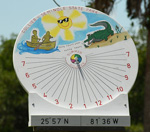 |
Naples |
Florida |
USA |
Equatorial Dial |
Dial 1104 |
| A whimsical equatorial dial set on a pole. The solid dial face has a drawing of canoeists opposite an alligator with its mouth open and.above them is a smiling sun wearing sunglasses. Time on the summer side is from 6:30am to 7:30pm while on the winter side, time is delineated from 7am to 7pm.(but still using daylight saving time). Both sides have mean solar time adjusted for longitude, about 24 minutes.. |
| |
| |
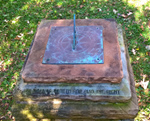 |
Nashotah |
Wisconsin |
USA |
Horizontal Dial |
Dial 845 |
| In a quite, shaded corner of the Nashotah House Theological Seminary is a copper alloy horizontal dial. The dial plate is a 10 inch square, 3/32 inches thick. The dial is engraved with several concentric circles with with large Roman hour marks on an outer ring from 5am to 7pm. Time is delineated in 5 minute increments on the outer circle, but includes an inner circle delineated in 15 minute increments. In the center of the dial is an 8-point compass rose with engraved directions. The quarter inch thick brass gnomon is a simple raised bar acting as style with an "S" shaped support. |
| |
| |
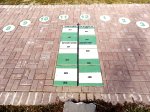 |
Nashville |
Tennessee |
USA |
Analemmatic Dial |
Dial 766 |
| A 16 x 12 foot analemmatic dial placed in the Experience Center of the 200 acre Ellington Agricultural Center. Dial is built of paver stones flush to the surroundings with painted inset circular hour marker paver stones and rectangular paver stones for the central date line. Directions for use are painted on the date line. |
| |
| |
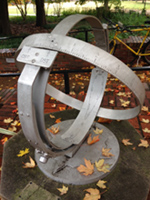 |
Nashville |
Tennessee |
USA |
Equatorial Dial |
Dial 853 |
| The equatorial dial made of aluminum operates on a unique principle. The equatorial time ring is allowed to rotate. Fixed to it on the upper ring section is a small hole that shines to the ring below. On the lower ring section is a plate with an engraved analemma, extending +/- 23.44 deg from the equator. The whole assembly is rotated until the sunlight spot falls on the analemma (with monthly marks to avoid ambiguity). One tells time using 5-minute time marks on the upper section of the equatorial ring read by one of two indicators either as central standard or daylight savings time. |
| |
| |
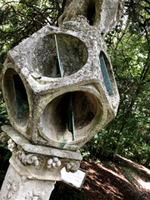 |
Nashville |
Tennessee |
USA |
Polyhedral Dial |
Dial 1051 |
| The dial is overgrown with lichen and stained with dirt. Underneath this rather shabby exterior is a fine polyhedral sundial with ten hemispherical dials arranged in a dodecahedron. Each dial is 8-in (20cm) in diameter fitted with a quarter-inch thick bronze gnomon. The gnomons are set in a common direction for the North Celestial Pole of approximately 51 deg latitude. The design and latitude leading to the the conclusion it is a copy of an 18th century English sundial. The dial is similar to NASS #27 in Hartford, CT. which was originally located at The Abbey, Storrington, Sussex south of London. The Nashville dial sits on an ornate flower-motif pillar approximately 8 feet high. Sitting on top of the dial is a shield and rampart lion, similar to the Hartford-Storrington Abbey sundial. |
| |
| |
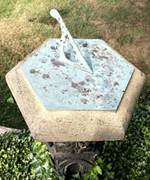 |
Nashville |
Tennessee |
USA |
Horizontal Dial |
Dial 1052 |
| A hexagonal shaped brass dial 9.5 inches (24cm) . Gnomon appears set for 34 deg and is bent to one side. The dial plate is marked in 15 minute intervals with Roman numeral hour marks. The dial is heavily corroded. Dial sets on cylindrical limestone pedestal with a hexagonal cornice top. |
| |
| |
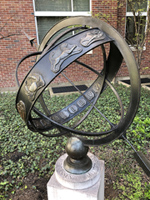 |
Nashville |
Tennessee |
USA |
Armillary Sphere |
Dial 1053 |
| A brass armillary sphere 3.5 feet (1.1m) in diameter with plates holding Roman numerals for each hour from 6am to 6pm. The outside of the equatorial band contains frieze symbols of the zodiac. The dial rests on a globe of stars. Limestone and cement plinth. |
| |
| |
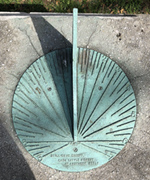 |
Nashville |
Tennessee |
USA |
Horizontal Dial |
Dial 1057 |
| Bronze 14 inch (36cm) horizontal dial. Arabic numerals mark hours with half and quarter hour marks. A simple solid triangular gnomon, set to 35 deg. On the pedestal there is a hand with a pointing finger, showing the way to the grave site of James Robertson and Dr. Felix Robertson, his son. |
| |
| |
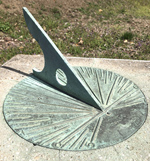 |
Nashville |
Tennessee |
USA |
Horizontal Dial |
Dial 1058 |
| Bronze horizontal dial, 14" (36 cm) diameter. Plain gnomon with hole in it, set to 37 deg. Hour lines with half and quarter hour marks. Arabic numbers mark the hours from 5Am to 7PM. Dial was originally erected in Centennial Park to commemorate one of Nashville's founders. Later moved to his grave site. |
| |
| |
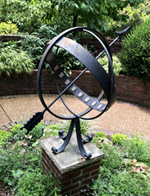 |
Nashville |
Tennessee |
USA |
Equatorial Dial |
Dial 1059 |
| 30 inch (76cm) black iron armillary sphere. Roman numerals mark the hours. Gnomon is a classic rod and arrow motif. Sits on a brick pedestal. |
| |
| |
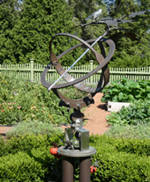 |
Nashville |
Tennessee |
USA |
Armillary Sphere |
Dial 1069 |
| This armillary sphere is based on a Chinese design with an equatorial ring containing Arabic hour marks but the meridian ring exists only below a longitudinal ring set to the dial's latitude. The dial presents Tennessee's identity and is dedicated to the school children of Tennessee. 4 copper columns support the dial, honoring the Greek and Roman tradition of placing a sundial in the center of a garden. The capital and base are cast bronze and the foundation is Tennessee crab orchard limestone. Surrounding the base are 5 tomato plants, the State fruit. 3 are enameled red to represent the three stars in the State flag. Sitting on the base is the eastern box turtle, State reptile. Branches from a tulip poplar, the State tree, extend from the north end of the gnomon and a mockingbird, the State bird, sits in the branches. The branches are made of forged bronze and the leaves are copper, cut by hand, then repousséd or shaped by hammering on the reverse side, then enameled. The mockingbird is made of raised and repousséd copper with enamel for color. The legs are bronze for strength. |
| |
| |
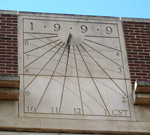 |
Nashville |
Tennessee |
USA |
Vertical Dial |
Dial 425 |
| A 6 x 7 foot vertical dial declining 16.4 deg east of south. The dial of limestone is integral to the building with a near square face, engraved lines and a small triangular gnomon. Hour marks are from 6am to 4pm, labeled between long hour lines. Solar declination lines are shown as dotted lines for the zodiac, including solstices and equinox. This dial was on the 2022 NASS Conference dial tour of Nashville. |
| |
| |
 |
Nassau Bay |
Texas |
USA |
Horizontal Dial |
Dial 714 |
| A cast concrete horizontal dial with a rugged steel water pipe gnomon. Dial face has hour and half hour marks with Roman hour numerals showing CDST and a compass rose with dial coordinates. A graph marked in the concrete shows EOT correction. |
| |
| |
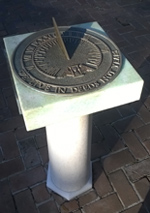 |
Natchez |
Mississippi |
USA |
Horizontal Dial |
Dial 887 |
| In 1716 the French built a fort on the bluffs of Natchez and named it Rosalie in honor of the Countess of Pontchartrain. In 1820 Peter Little, who came to Natchez from Pennsylvania in 1798 at the age of 17, purchased a portion of that land on which to build his home. He decided to keep the name Rosalie in honor of the fort and its settlers. The mansion and land was purchased in 1938 by Mississippi State Society, Daughters of the American Revolution. |
| |
| |
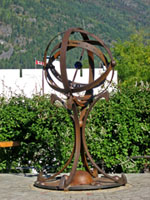 |
Nelson |
British Columbia |
Canada |
Armillary Sphere |
Dial 584 |
| This is a lovely dial in a lovely setting. The armillary of wrought iron is intricately and carefully done and blends with the surrounding garden that uses wrought iron railings made with the same look to continue the theme of the sundial. The dial is a 4 foot wide by 6 foot tall armillary of mild steel and blown glass with punched Roman numerals of the hours on the equatorial ring. The ecliptic ring includes zodiacal symbols. Dial base has a 12 inch hemispherical time capsule to be opened October 14, 2015. |
| |
| |
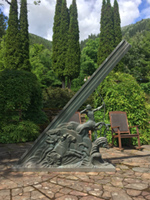 |
Nelson |
British Columbia |
Canada |
Horizontal Dial |
Dial 966 |
| The elegant bronze gnomon is 6 foot high with a modern interpretation of the zodiac sculptured into the lower half. The zodiac is represented by reliefs of Leo, Taurus, Pisces, Gemini, Virgo, and Sagittarius with his bow. The dial face is integrated into the plaza with a stainless steel chapter ring about 12 feet in diameter. The chapter ring has ornate grill work and Roman numerals to mark the hours. A small disk shows the Equation of Time correction in polar form with the months labelled along the circumference and EOT shown radially. The resulting graph looks somewhat like a kidney. |
| |
| |
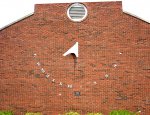 |
New Albany |
Indiana |
USA |
Vertical Dial |
Dial 704 |
| A 15 foot wide vertical dial declining 35 deg east of south on the brick face of a commercial building. Dial face has Roman numerals without hour lines. |
| |
| |
|
New Bedford |
Massachusetts |
USA |
Vertical Dial |
Dial 163 |
| 1820 Federal style building owned by the Univ. of Mass. at Dartmouth. Referred to as the Sundial building because of a vertical dial over the main entrance. |
| |
| |
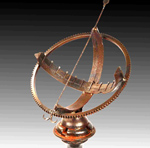 |
New Berlin |
Wisconsin |
USA |
Equatorial Dial |
Dial 865 |
| This whimsical yet elegant equatorial dial is made from old farm implements. The materials are high carbon steel and cast iron parts. The 18-inch gear is a flywheel from an International Harvester farm tractor. The base is a harrow blade for tilling soil. The harrow blades ride on a square shaft and the blades are separated by spacers seen the base of the sundial. The meridian arcs are soil tillers that would ride on a drum behind the tractor. These pieces are very challenging to weld because they are dissimilar materials. Horseshoe nails mark the hours on the equatorial arc. No hour numbers are used, just the nails. The gnomon is an arrow rod. |
| |
| |
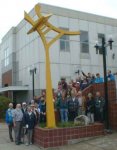 |
New Britain |
Connecticut |
USA |
Vertical Dial |
Dial 111 |
| A 19 ft steel sculpture named 'Sheng'. Commissioned by the Connecticut Commission on the Arts in 1987 and designed by Robert Adzema. Basically a combination East and West direct dial with a circular gnomon. |
| |
| |
 |
New Harmony |
Indiana |
USA |
Vertical Dial |
Dial 620 |
| A historic wood and iron vertical dial 34 inches wide x 42 inches high x 1-3/4 inches thick. This original Harmonist dial was made in 1821 by the Harmonie Society, a group of Lutheran separatists from Germany who settled in the US in the early 1800's. The original dial hung on a private house; when fire destroyed the house in 1844, the dial was rescued and placed on the south wall of Community House 2, located across the street from the destroyed house. A modern replica (similar at least) now is placed on the exterior wall and the original historic dial is on display inside and can be seen on a daily tour. |
| |
| |
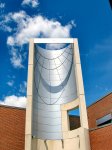 |
New Haven |
Connecticut |
USA |
Cylindrical Dial |
Dial 664 |
| A nearly 50 foot tall vertical concave cylindrical projection dial of precast concrete lined with aluminum panels and with an aluminum band projection gnomon. The curvilinear interior surface is inscribed with vertical hour lines and horizontal solstice and equinox marks. The band gnomon features a 2.5 inch diameter hole that projects an image of the sun on the silver-colored interior surface against a shadow cast by the gnomon band itself. |
| |
| |
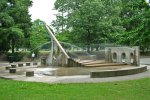 |
New Haven |
Connecticut |
USA |
Horizontal Dial |
Dial 279 |
| Large horizontal dial 17 ft. diameter with concrete gnomon 20 ft. high. Hour marks include longitude correction. Dial has a circular layout with a large sundial arm that sprays water on one side, a curved bench for sitting on the opposite side, a wading pool in between and a curved wall with three large oval holes cut out on one side. The sun shines through the wall onto the number of the sundial. |
| |
| |
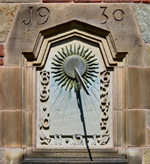 |
New Haven |
Connecticut |
USA |
Vertical Dial |
Dial 30 |
| Vertical dial on Sterling Library. Rectangular stone with hour lines and Arabic numbers. Gnomon is a plain rod emanating from a sunburst. Stonework shows it to be built into the wall of the library. |
| |
| |
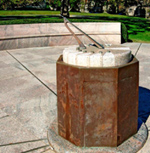 |
New London |
Connecticut |
USA |
Horizontal Dial |
Dial 473 |
| A horizontal dial of striking modern design about 24 inches in diameter. The dial face is granite with milled wedges, leaving hour lines from 6 am to 6 pm. Hours are represented by small round bronze markers. The gnomon is of unusual design. When installed, the gnomon had a vertical glass plate below the style. The dial doubled as a fountain - water flowed from the top of the gnomon down the glass plate. Each of the bronze hour markers also had a small spray of water. The round granite dial is slightly smaller than the octagonal pedestal and base. A small trough between them recovers water from the fountain. |
| |
| |
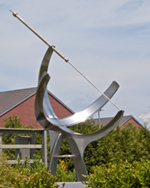 |
New Milford |
Connecticut |
USA |
Equatorial Dial |
Dial 817 |
| This 9-foot stainless steel equatorial is the centerpiece of "Galileo's Garden". The sundial was built and dedicated in memory of Kathleen Fischer, a sixth-grade science teacher who inspired many students to pursue science. The sundial is an open armillary, with an adjustable hour band so that both local solar time and civil time can be read. At the tip of the gnomon is a bronze and brass true-size rendering of Galileo’s first telescope, honoring the 400 years since Galileo explored the heavens. The North American Sundial Society was privileged to donate to this effort. |
| |
| |
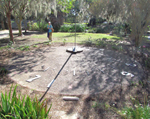 |
New Orleans |
Louisiana |
USA |
Horizontal Dial |
Dial 846 |
| Amidst the gardens in City Park is the Bacher Sundial, an 18-foot diameter pebbled concrete horizontal sundial set flush with the ground. The gnomon is well made, with curves nicely cut, edges straight, and the weld fillet is smooth and blends the upright with the base nicely. It is set on a low circular dais set considerably south of the center of the circular dial face. The gnomon is a simple iron blade 144 inches in length along the style edge. At the base, slots for anchoring the gnomon allow adjustment of 8-10 degrees to align to true north. Currently the gnomon sits near the center of the range, but can be pushed by hand to either end of the range. With loose nuts holding the gnomon, it appears canted at the base. Tightening the nuts could restore gnomon to its necessary 30 degree angle, but deterioration of the bolt anchors may prevent full tightening. |
| |
| |
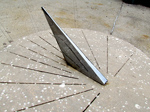 |
New Orleans |
Louisiana |
USA |
Horizontal Dial |
Dial 851 |
| The concrete dial is 32 inches in diameter with simple hour lines without any further ornamentation. The foot high gnomon is a stainless steel wedge, tapering slightly from base to top. An interesting effect of looking at the sundial and gnomon: by moving your head, the hour lines reflected in the gnomon can line up with lines on the other side of the gnomon. The dial sits on a 3 foot high concrete pedestal. |
| |
| |
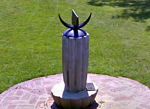 |
New Orleans |
Louisiana |
USA |
Equatorial Dial |
Dial 273 |
| Approximately 14-inch bronze sun dial consisting of an standard equatorial hour ring. However the gnomon is a thin semi-circular disk. The top straight edge is the style casting its shadow onto the equatorial ring. All of this sites on top a low bronze metal dome base. |
| |
| |
 |
New Orleans |
Louisiana |
USA |
Horizontal Dial |
Dial 237 |
| This large horizontal sundial sits on a slightly pink concrete egg-shaped base 24 x 17.5 feet. This dais is nearly at ground level. The gnomon is an elegant stainless steel blade approximately 8 feet high sitting at the widest part of the dais, with hours marked around the dais edge with small bronze animals at each hour from 6am to 6pm. For example the noon hour is represented by a turtle. |
| |
| |
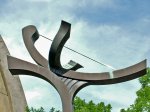 |
New York |
New York |
USA |
Equatorial Dial |
Dial 140 |
| A 20' H x 10' W x 5' D Equatorial in Bronze and Stainless Steel. Entitled "Song to the Sun." Dial by Robert Adzema; gift of George and Annette Murphy in 1984. |
| |
| |
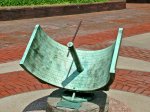 |
New York |
New York |
USA |
Cylindrical Dial |
Dial 215 |
| A half-cylinder equatorial dial whose body structure is exactly the same as the one (#28) at Trinity College, Hartford, CT, only the pedestal here is lower. Named ?The Camp Columbia Sundial?, a gift of Camp Columbia to memorialize Dean Hennessy (1917-1991). |
| |
| |
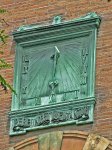 |
New York |
New York |
USA |
Vertical Dial |
Dial 245 |
| 3 x 4 feet bronze vertical declining S 28° W, 30 feet above the street level. |
| |
| |
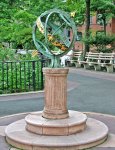 |
New York |
New York |
USA |
Armillary Sphere |
Dial 248 |
| The armillary dial is 30 inches in diameter, built of bronze with a cast stone pedestal. On the outside of equatorial band are golden zodiac signs. Inside the band are roman numerals for hours from 6 am to 6 pm. The dial was vandalized but was refurbished in 2000 and moved a short distance in Parks Dept. renovation. Sal Ton Landscape was the general contractor; Kenneth Lynch & Sons repaired the sundial and made a complete new cast stone fluded base in 2000. |
| |
| |
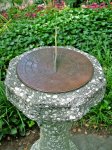 |
New York |
New York |
USA |
Horizontal Dial |
Dial 249 |
| A 10 inch diameter rough brass horizontal dial, painted brown, on a 3 foot cement pedestal. Gnomon is damaged. Roman hour numerals. Dial sits atop a cast stone pedestal about 3 feet high. |
| |
| |
 |
New York |
New York |
USA |
Globe or Hemispheric |
Dial 250 |
| Granite model of old roman hemicyclium dial with beautiful horizontal bronze gnomon with figure of woman. Hour and date lines may be incorrect. Slightly vandalized and chipped. This dial is a detail of a larger park bench that itself was designed to show time on the equinoxes; refer to Dial 614. The park bench alignment is nominally north but this dial may be misaligned as the Roman hour numbers inscribed on the face run clockwise, incorrect for a south-facing dial. Dial sits atop a large stone park bench. |
| |
| |
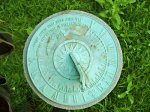 |
New York |
New York |
USA |
Horizontal Dial |
Dial 251 |
| An 11 inch diameter bronze horizontal dial on a 3 foot pedestal. Tip of gnomon is broken. |
| |
| |
|
New York |
New York |
USA |
Horizontal Dial |
Dial 252 |
| Sheet Metal Octagonal. Built by a prisoner. |
| |
| |
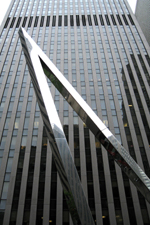 |
New York |
New York |
USA |
Sculpture/Artwork |
Dial 873 |
| The Sun Triangle is a 50-foot sculpture of polished stainless steel set upon a leaning 20-foot stainless steel pole, creating a futuristic look. The sides of the triangle are aligned such that steepest side points to the sun at noon for the summer solstice at an altitude of 73 degrees at solar noon (12:48pm Daylight Saving Time) while the lower side of the triangle points to the winter solstice at an angle of 26 degrees. The upper side and longest side of the triangle points to the the noonday sun on the spring and fall equinoxes. |
| |
| |
 |
New York |
New York |
USA |
Vertical Dial |
Dial 563 |
| A large vertical dial declining east approximately 45? and displaying fanciful furniture. Hour lines are present but are difficult to see; hour numerals are not shown. Summer and winter solstice lines are shown with the winter solstice line near the gnomon foot because of the declination. The curved line shown for the equinox should be straight.
Six individual "Cultural Arcs" are positioned at specific time points on the dial face and are accompanied by upstanding dial furniture. Each "Cultural Arc" references distinct and in some cases overlapping cultural traditions and is made from 1/2" sheet aluminum, with a permanent (powder coated) color finish. Each "Cultural Arc" contains symbolic and aesthetic elements reflecting the ebb and flow of migration in the local East Harlem population. |
| |
| |
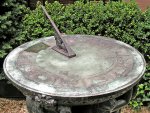 |
New York |
New York |
USA |
Horizontal Dial |
Dial 603 |
| A cast bronze horizontal dial approximately 30 inches diameter. The dial face includes the motto, astrological symbols of the ecliptic with Roman numerals. The 40-inch high cast pedestal sculpture depicts the three muses supporting the dial. This dial is visible from the street in front of the residence. |
| |
| |
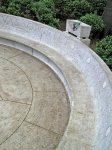 |
New York |
New York |
USA |
Sun Alignment |
Dial 614 |
| A granite park bench about 30 feet diameter whose bench shelf was designed to cast a shadow indicating time on the equinoxes. Individual curved lines corresponding to the bench shadows mark 10AM, Noon and 2PM. Known as the Waldo Hutchins Bench, the bench includes a second hemicyclium dial above its backrest; refer to Dial 250. Dial alignment may not be accurate. |
| |
| |
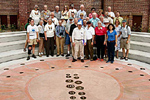 |
Newark |
New Jersey |
USA |
Analemmatic Dial |
Dial 1054 |
| An elliptical analemmatic sundial done in a circular motif representing the sun. Dial is in colored concrete and the Zodiac walkway is a series of circles with the month's number. The time is properly marked on the ellipse with a circular marker, but the hour number is at the end of the sun's "flames" on the circumference of a large circle containing the rest of the dial |
| |
| |
|
Newark |
Ohio |
USA |
Analemmatic Dial |
Dial 460 |
| An analemmatic dial with stone markers for the hours |
| |
| |
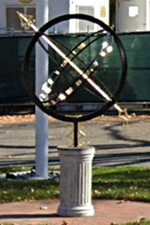 |
Newburyport |
Massachusetts |
USA |
Armillary Sphere |
Dial 443 |
| This 4-ft (1.2m) diameter armillary sphere is made of galvanized, painted and gold leafed steel. The dial was forged and welded by Cassidy Brothers Forge. It was "Colorgalvanized" by Duncan Industries and gold leafed. It was made to specifications from Albert Waugh's book on sundials, including latitude and longitude corrections. The sundial is mounted on a cast stone pedestal and stands about 8-ft (2.4m) high. |
| |
| |
|
Newcastle |
Maine |
USA |
Horizontal Dial |
Dial 427 |
| A small horizontal dial with an interesting history. In 1997 when the dial was installed, the following is quoted of designer and builder Jim Estey: "We set it by our watches," Jim said, and then glued it down to its stand. That means it cannot be reset when the sun and time changes, but visitors will have to compensate." |
| |
| |
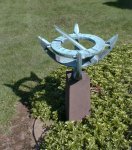 |
Newington |
Connecticut |
USA |
Horizontal Dial |
Dial 83 |
| Bronze horizontal ring, suspended by curved semi-circles, with gnomon rising from the center toward the North. "...you can see resemblances to an anchor, a gimbal, and a mariner's compass" says designer Searle Lansing-Jones. |
| |
| |
 |
Newington |
Connecticut |
USA |
Analemmatic Dial |
Dial 1123 |
| This is an analemmatic sundial designed by a team of four eighth grade students in 2017. This was a project that incorporated four classes: Geometry, 8th Grade Science unit on Solar System, Aerospace Science unit on air navigation, and Engineering Design. The 8th grade class was split into six teams of about four students each in a competition for best design. The principal picked the winning design and the winning team with the sundial impressed him so much that their project was presented to the school superintendent. He was so impressed that he had a professional landscape company build the sundial. It took about a year to build, with the original student designers coming back for a ribbon cutting ceremony. The dial is made of ceramic tile with tiles engraved with the months in the zodiac walkway. |
| |
| |
 |
Newport |
Rhode Island |
USA |
Vertical Dial |
Dial 671 |
| An 8x8 foot vertical dial of carved stone with hour lines and Arabic numerals and with Zodiacal symbols around dial perimeter. Dial declines to the west and has a bronze gnomon.
Access to view dial is available to all campus visitors. |
| |
| |
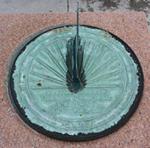 |
Newport |
Rhode Island |
USA |
Horizontal Dial |
Dial 1077 |
| Farenholt sundial for U.S. Naval Hospital Newport Rhode Island. This cast bronze dial was designed and commissioned by RADM Farenholt for U.S. Naval Hospitals at bases where he was commanding officer, visited, or had special meaning to him. The dial is 18 inches (46cm) in diameter. The outer chapter ring has the motto, followed by a chapter ring with Arabic hours 6am to 6pm, raised hour lines that radiate from near the foot of the gnomon and short half-hour lines. The gnomon has graceful curves and a quatrefoil cut-out in the center. Below the gnomon is the naval command name, followed by the commissioning date in the southern portion of the hours chapter ring. Dial sits atop a circular stone pedestal with beveled capital. |
| |